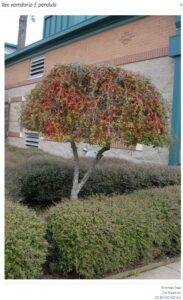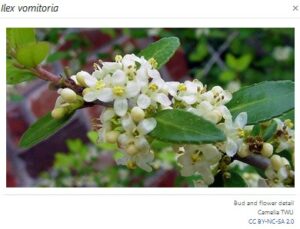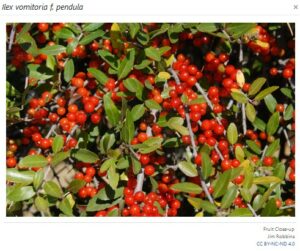Ilex Vomitoria F. Pendula (Weeping Yaupon Holly)
go.ncsu.edu/readext?1072694
en Español / em Português
El inglés es el idioma de control de esta página. En la medida en que haya algún conflicto entre la traducción al inglés y la traducción, el inglés prevalece.
Al hacer clic en el enlace de traducción se activa un servicio de traducción gratuito para convertir la página al español. Al igual que con cualquier traducción por Internet, la conversión no es sensible al contexto y puede que no traduzca el texto en su significado original. NC State Extension no garantiza la exactitud del texto traducido. Por favor, tenga en cuenta que algunas aplicaciones y/o servicios pueden no funcionar como se espera cuando se traducen.
Português
Inglês é o idioma de controle desta página. Na medida que haja algum conflito entre o texto original em Inglês e a tradução, o Inglês prevalece.
Ao clicar no link de tradução, um serviço gratuito de tradução será ativado para converter a página para o Português. Como em qualquer tradução pela internet, a conversão não é sensivel ao contexto e pode não ocorrer a tradução para o significado orginal. O serviço de Extensão da Carolina do Norte (NC State Extension) não garante a exatidão do texto traduzido. Por favor, observe que algumas funções ou serviços podem não funcionar como esperado após a tradução.
English
English is the controlling language of this page. To the extent there is any conflict between the English text and the translation, English controls.
Clicking on the translation link activates a free translation service to convert the page to Spanish. As with any Internet translation, the conversion is not context-sensitive and may not translate the text to its original meaning. NC State Extension does not guarantee the accuracy of the translated text. Please note that some applications and/or services may not function as expected when translated.
Collapse ▲Ilex vomitoria f. pendula (Weeping Yaupon Holly)
Article by Extension Master Gardener℠ volunteer Kathryn Copley

Trimmed Tree; Jim Robbins; CC BY-NC-ND 4.0
Weeping Yaupon Holly is a native, rapidly growing, easily transplanted broadleaf evergreen shrub or small tree that can reach 15 to sometimes 30 feet tall and 6 to 12 feet wide. Give it full sun (6 or more hours of direct sunlight a day) or partial shade (2 to 6 hours of direct sun), though it will produce more fruit and have a thicker canopy with more sun.
It tolerates heavy pruning, and it tolerates wind and hot climates better than most evergreen hollies. It is deer resistant and easy to grow with a tolerance for drought, occasional flooding, salt, and urban conditions.
Plants are dioecious (separate male and female plants). Greenish-white inconspicuous, nectar-rich, fragrant flowers appear in spring on separate male and female plants. Female plants need a male pollinator in order to produce their large clusters of small translucent red berries in fall that usually last until spring.
Its weeping form makes a great specimen or accent plant, and it is good for topiary. The leaves are small, leathery and glossy green and are not prickly like other hollies. Its tightly packed evergreen leaves make it ideal for sheering. The plant will form thickets unless suckers are removed. Flowers attract pollinators and fruits are attractive to birds and small mammals.
This plant has a high flammability rating, so don’t plant it within your home’s defensible space. Poison severity to humans is low but ingesting the fruits can cause nausea, vomiting, and diarrhea.
Resources
- NC Extension Plant Toolbox:
- Sea Grant North Carolina | Native Plant Picks
- Home & Garden Center: Holly
By Kathryn Copley, Extension Master Gardener SM Volunteer, Brunswick County, NC For more information on gardening in Brunswick County, please call the Brunswick County Cooperative Extension Office 910-253-2610





